| The Fair Deal Reading with Questions |
|---|
| www.studenthandouts.com ↣ American History ↣ American History Readings |
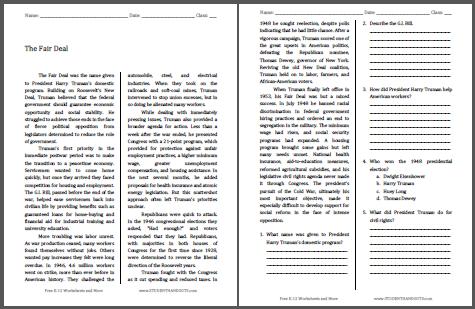 The Fair Deal was the name given to President Harry Truman's domestic program. Building on Roosevelt's New Deal, Truman believed that the federal government should guarantee economic opportunity and social stability. He struggled to achieve those ends in the face of fierce political opposition from legislators determined to reduce the role of government.
The Fair Deal was the name given to President Harry Truman's domestic program. Building on Roosevelt's New Deal, Truman believed that the federal government should guarantee economic opportunity and social stability. He struggled to achieve those ends in the face of fierce political opposition from legislators determined to reduce the role of government.
Truman's first priority in the immediate postwar period was to make the transition to a peacetime economy. Servicemen wanted to come home quickly, but once they arrived they faced competition for housing and employment. The G.I. Bill, passed before the end of the war, helped ease servicemen back into civilian life by providing benefits such as guaranteed loans for home-buying and financial aid for industrial training and university education. More troubling was labor unrest. As war production ceased, many workers found themselves without jobs. Others wanted pay increases they felt were long overdue. In 1946, 4.6 million workers went on strike, more than ever before in American history. They challenged the automobile, steel, and electrical industries. When they took on the railroads and soft-coal mines, Truman intervened to stop union excesses, but in so doing he alienated many workers. While dealing with immediately pressing issues, Truman also provided a broader agenda for action. Less than a week after the war ended, he presented Congress with a 21-point program, which provided for protection against unfair employment practices, a higher minimum wage, greater unemployment compensation, and housing assistance. In the next several months, he added proposals for health insurance and atomic energy legislation. But this scattershot approach often left Truman's priorities unclear. Republicans were quick to attack. In the 1946 congressional elections they asked, "Had enough?" and voters responded that they had. Republicans, with majorities in both houses of Congress for the first time since 1928, were determined to reverse the liberal direction of the Roosevelt years. Truman fought with the Congress as it cut spending and reduced taxes. In 1948 he sought reelection, despite polls indicating that he had little chance. After a vigorous campaign, Truman scored one of the great upsets in American politics, defeating the Republican nominee, Thomas Dewey, governor of New York. Reviving the old New Deal coalition, Truman held on to labor, farmers, and African-American voters. When Truman finally left office in 1953, his Fair Deal was but a mixed success. In July 1948 he banned racial discrimination in federal government hiring practices and ordered an end to segregation in the military. The minimum wage had risen, and social security programs had expanded. A housing program brought some gains but left many needs unmet. National health insurance, aid-to-education measures, reformed agricultural subsidies, and his legislative civil rights agenda never made it through Congress. The president's pursuit of the Cold War, ultimately his most important objective, made it especially difficult to develop support for social reform in the face of intense opposition. Click here to print. Answer Key: (1) Fair Deal; (2) Helped ease servicemen back into civilian life by providing benefits such as guaranteed loans for home-buying and financial aid for industrial training and university education; (3) 21-point program that included protection against unfair employment practices, a higher minimum wage, and greater unemployment compensation; (4) B - Harry Truman; (5) Banned racial discrimination in federal government hiring practices and ordered an end to segregation. |
 | 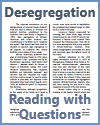 | 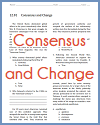 | 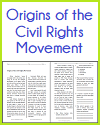 |  | 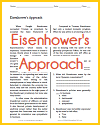 |
| Postwar America Worksheets | Postwar America Learning and Study Games |
| Postwar America Outlines and PowerPoints | Postwar America Maps and Pictures |
| Postwar America Miscellany | Postwar America Books and Films |
| www.studenthandouts.com ↣ American History ↣ American History Readings |








